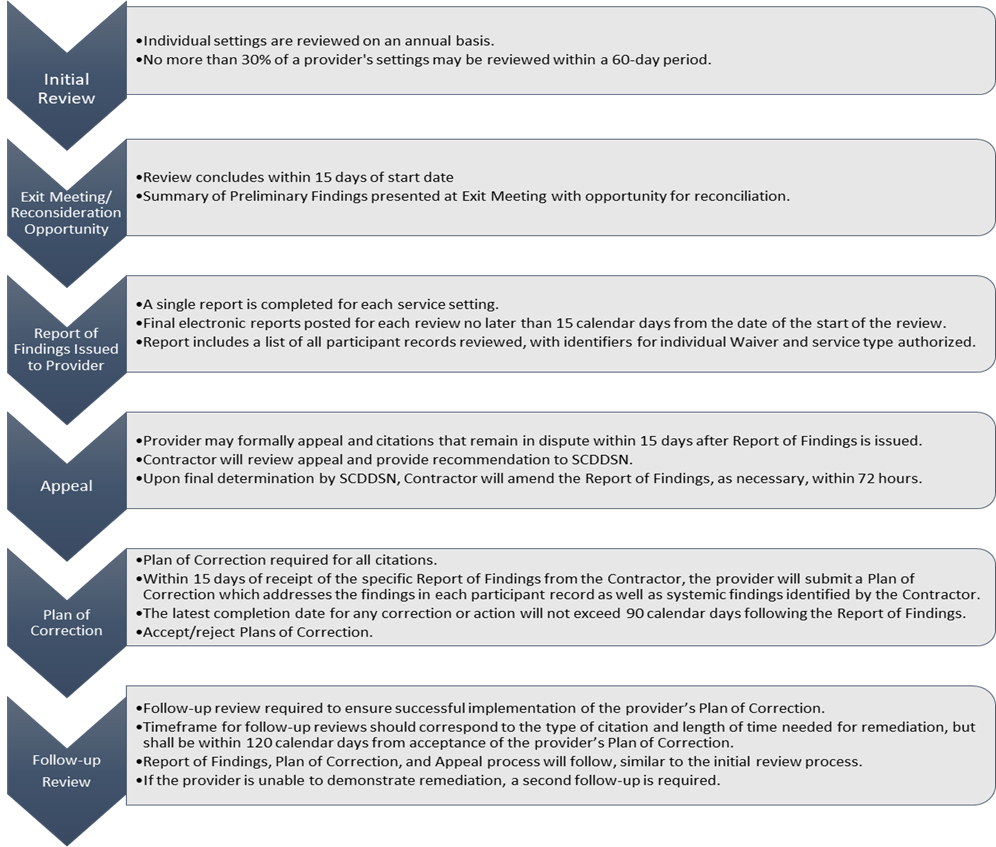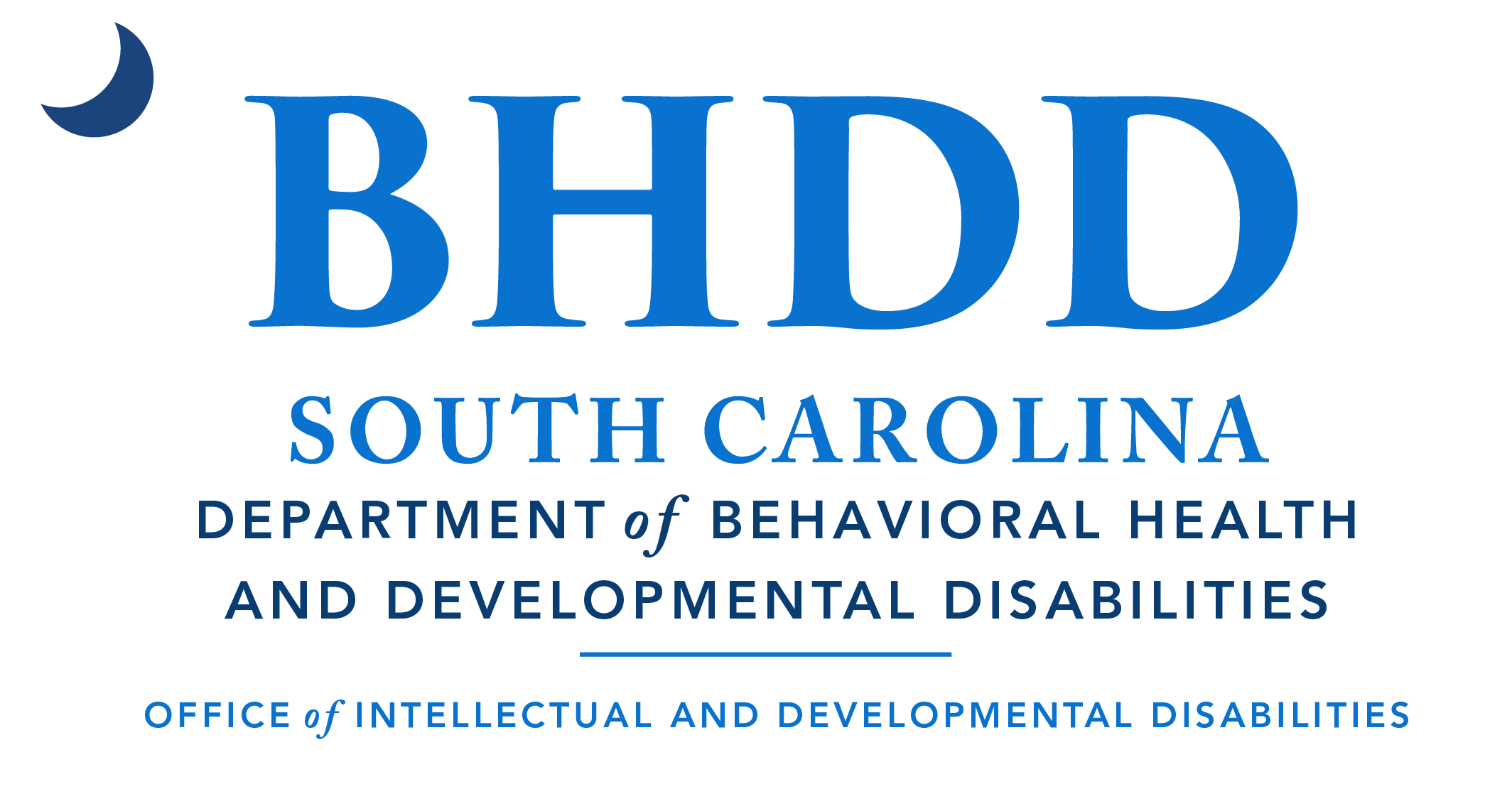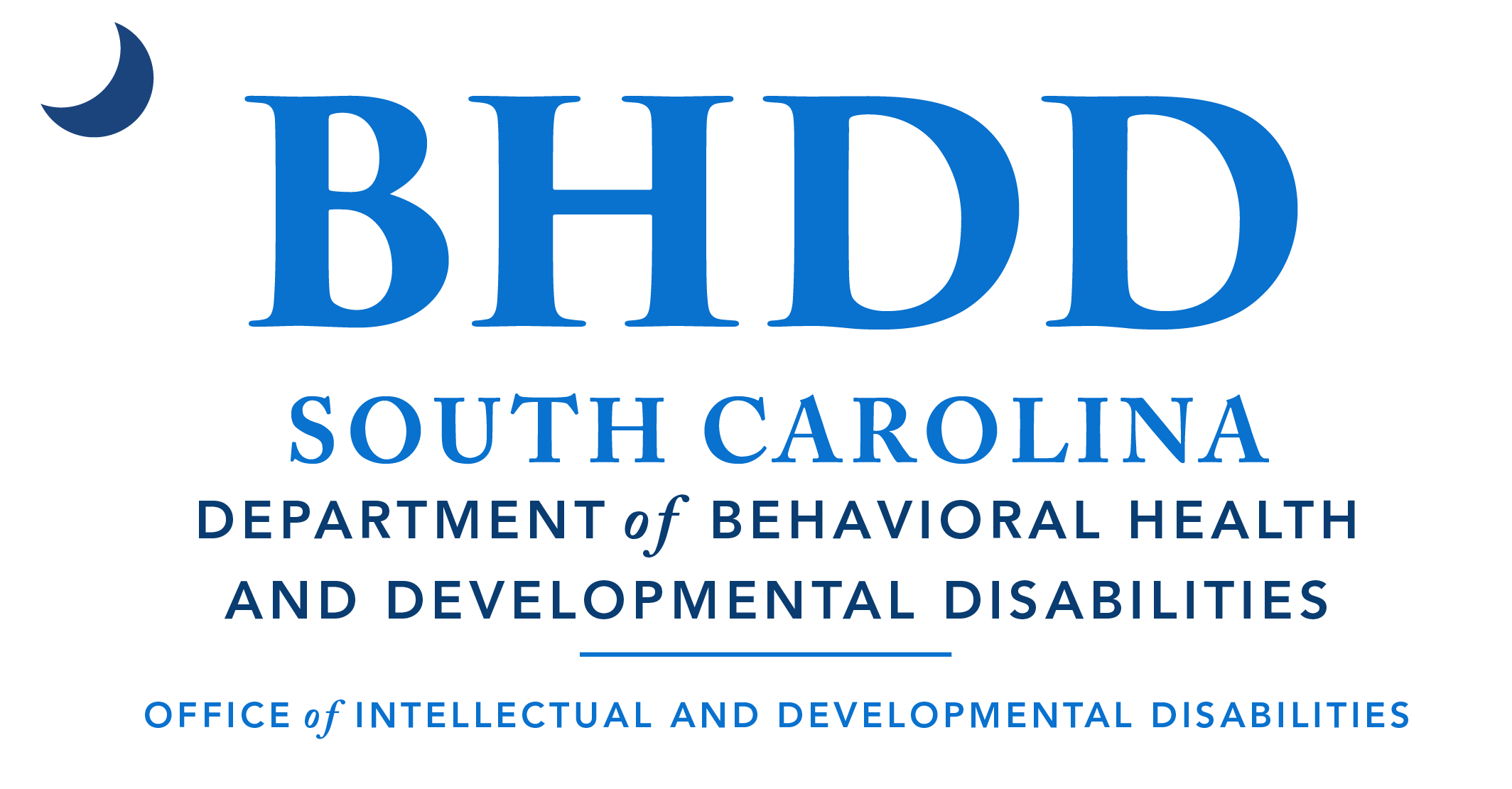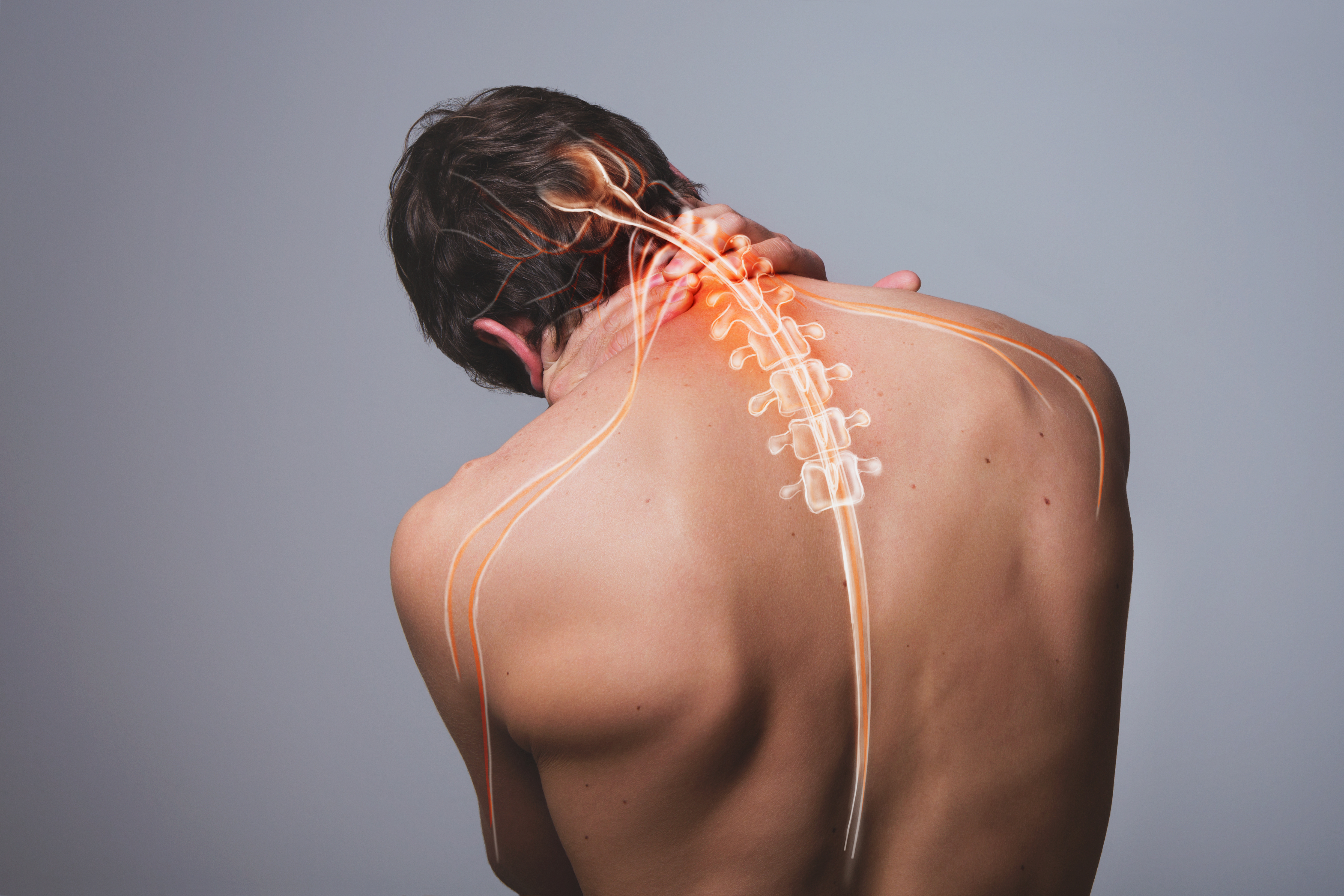State law requires licensing of certain programs and residential facilities. This licensing relates to the health and safety aspects of facilities and services. The law authorizes the establishment of standards for the qualifications of staff, staff ratios, fire safety, medication management, facility size and construction, storage of hazardous liquids and health maintenance. All Residential and Facility-Based Day programs must be licensed. Licensing activities occur on a regular basis and may involve staff from BHDD-OIDD, DHEC, and/or the State Fire Marshall’s Office. BHDD-OIDD has contracted with a Quality Improvement Organization (QIO) to conduct licensing inspections. The Application to Operate will continue to be submitted to BHDD-OIDD, but the QIO will complete the inspection. Upon approval, BHDD-OIDD will issue the license to the provider to operate the facility. DHEC will continue to inspect all CRCF and ICF/IID locations and issue licenses for these homes.
The primary focus of the Licensing/Certification review is to assure basic health, safety and welfare standards. Key indicators measure the following:
- The facility’s environment promotes the consumers’ health and safety.
- The physical operation of each facility, to include fire marshal inspections, HVAC, Water Quality, and Health and Sanitation.
- There must be evidence of Fire Safety training and evacuation, Disaster Preparedness, First Aid supplies and other emergency items.
- Facilities must provide documentation of continuous, coordinated health care, appropriate medical follow-up, and assistance with medications (as indicated in each consumers Plan).
- Facilities must demonstrate understanding and application of all BHDD-OIDD policies regarding Abuse/Neglect and Exploitation and Critical Incidents. Any instances of suspected abuse, neglect and/or exploitation as well as concerns relating to health and safety has resulted in appropriate action in accordance with BHDD-OIDD policy.
The facility review process must include an annual, on-site review. During the course of the on-site review, if substandard or noncompliant performance is found, the provider will be expected to take immediate corrective action.
Follow-up Visits
As part of BHDD-OIDD’s continuing efforts to improve the quality of services to people with lifelong disabilities, follow-up visits are completed with provider organizations. The purpose of the follow-up is to determine whether the plans of correction submitted to the QIO have been implemented for all programs and locations.
In order to utilize staff and resources more effectively during this economic time, part of the follow-up process will be an opportunity for providers to submit evidence that the citations have been corrected. Documentation that verifies corrections have been made can be submitted to the QIO prior to an onsite visit. This information should not be a repeat submission of the Plan of Correction. If the submitted documentation verifies correction, then an onsite review of that standard would not be necessary. The submission of documentation to verify correction of citations is voluntary, but a lack of documentation may necessitate an on-site review.
A report identifying the status of all citations will be issued after the completion of the follow-up survey.
- MAPS Provider Guide
- FY26 Day Licensing Review Indicators (PDF)
- FY26 Residential Licensing Indicators (PDF)
- FY25 Day Services Licensing Indicators (PDF)
- FY25 Residential Licensing Indicators (PDF)
- State Fire Informational Bulletin (PDF)
- Day Services Licensing Prep FY24 (PDF)
- Residential Services Licensing Prep FY24 (PDF)
- OSFM Requirements & Protocol (PDF)
- Fire Watch Procedures (PDF)
Licensing Reviews FAQ
BHDD-OIDD’s Administrative Compliance and Individual Services (ACIS) Reviews, Licensing Reviews, and Day/Residential Observation process are completed by a Federally Recognized Quality Improvement Organization (QIO).
Plans of Correction-Licensing Reviews
Reconsideration/ Appeal-Licensing Reviews
Follow-up Licensing Reviews
Will I be notified prior to a Licensing Review?
Residential and Day Service Providers will receive same-day notification of all licensing reviews. The QIO will contact the provider in the early morning to let them know that a licensing review will be scheduled for later that same day at the designated locations. The provider can then indicate which location will be the starting point where provider staff will meet the licensing review staff.
What kind of Residential Settings will be inspected by the QIO?
The QIO will conduct licensing inspections for all SLP-II, CTH-II, CTH-I and CIRS locations using the BHDD-OIDD Residential Licensing Standards.
How frequently will my locations be inspected for Licensing?
All BHDD-OIDD Day and Respite Settings will be licensed annually. SLP-II, CTH-II, CTH-I and CIRS settings will also be licensed annually. DHEC will determine the schedule for licensing inspections for ICFs/IID and CRCFs.
Can my organization arrange to have the licensing review for all residential settings completed at one time? No.
The QIO will complete Licensing Reviews for approximately 30% of a provider’s residential service locations at one time.
Will DHEC still inspect ICFs/IID and CRCFs? Yes.
DHEC will continue to inspect all ICFs/IID and CRCFs.
Will I need documentation on-site at each residential location? Yes.
Providers will need to maintain documentation on-site at each residential service location. Copies are acceptable in lieu of the original documents. Required documentation will include the following:
- Most recent State Fire Marshal Inspection
- Water Analysis – If home is on well water
- Health and Sanitation Inspection – If licensing for Children
- Policy for disposition of medication
- Key assessments if any form of lockable storage is not available
- Current MARs and past MARs (90 days)
- Medication Error Reports (current and past 90 days)
- Medication Error Rate (current and past 90 days)
- Self-Administration Assessments (if any individual’s Self Administer their own medications)
- SLP – Medication storage assessments if medications are not in the apartments
- Pet Vaccinations – If pets are in the home
- Approved Exceptions, if any, as granted by BHDD-OIDD
Will I need documentation on-site at each Day Service Location? Yes.
Providers will need to maintain documentation on-site at each day service location, to include the following:
- Most recent State Fire Marshal Inspection
- Fire and disaster drills for the last year
- Policy addressing alternate coverage for staff members who are ill
- Most recent fire marshal, electrical systems, HVAC, and sprinkler system inspections
- Monthly vehicle maintenance records (past year)
- Daily vehicle checklists (past 90 days)
- Medication Error Reports (current and past 90 days)
- Medication Error Rate (current and past 90 days)
- Current and past MAR’s (past 90 days)
- Policy for disposition of medication
- Written authorization for consumers to be administered medication (all individuals who receive medications)
- Complete Staff list of staff that work in the Day Program
- Staff defensive driver training and fire safety training
- Any approved Exceptions granted by BHDD-OIDD
Does the Residential Director or a supervisor have to be present? No.
Any designated provider staff person may be present at the residential location during a licensing inspection. The Residential Director or House Manager does not have to be present. The provider just needs to have someone available to open the home and remain present during the inspection and to locate the documentation needed for review.
How is the Medication Error Rate calculated?
For each service location where medications are given, providers are required to record the monthly error rate expressed as a whole number with three (3) decimal points (number of errors divided by the total number of medications passed for each calendar month) along with the number of errors/events. Error rates are not to be used as a substitute for the actual number of errors/events. For clarification, medications passed will include ALL medications: oral, injections, topical, drops, and breathing treatments. The Consulting Pharmacy can usually provide this information for providers.
What kind of documentation is acceptable to demonstrate remediation?
Examples of documentation that may be submitted for Follow-up Reviews include:
- Invoice for work performed by a contractor (including the address and/or other identifying information);
- Receipt for items that needed replacement (with information that would verify placement at the location cited);
- Photograph of repair/corrected issue;
- Training summary and signature sheet;
- Report from HVAC, Electrical, State Fire Marshal, or Water Quality Inspections; and/or
- Other documentation that would verify corrective action related to the indicator cited.
Providers should ensure that any documentation provided clearly demonstrated the action taken was specifically for the location cited.
The Follow-up Review will verify that the provider implemented their POC by targeted completion date. Receipts, work orders, invoices, etc., must provide enough detail to show that the correction was for the actual citation at the location referenced. The QIO often receives invoices for work that includes the provider administration office for work that could have happened at any location (i.e., pest control, carpet cleaning). Again, providers should ensure that any documentation provided clearly demonstrated the action taken was specifically for the location cited.
Can I use documentation from my organization’s quarterly unannounced visits to help demonstrate remediation? Yes.
Providers should keep in mind that many of the items frequently cited during licensing inspections are items that could be acknowledged and corrected during the provider’s own quarterly unannounced visits which are required for all residential settings, as required in the BHDD-OIDD Administrative Standards.
How will my organization know if there were citations during the licensing review?
The QIO may verbally state any finding noted with the provider representative on-site. This dialogue may help with the location of documentation that may have been previously missed, or help explain other circumstances. In addition, the Provider will receive a brief, written summary of findings for each location reviewed no later than noon of the next business day. The Provider may upload additional information for consideration within 24 hours.
The Report of Findings will be posted to the QIO portal within 30 days from the exit summary. The report will be made available on the QIO portal to designated provider staff.
Do I have to provide a Plan of Correction for each citation? Yes.
A Plan of Correction will be required for each citation. The action plan should address both the individual citation and systemic corrections.
What is the time frame to submit a Plan of Correction?
A Plan of Correction will be due within 15 days of the provider’s receipt of the Report of Findings for Licensing Reviews, unless individual findings are appealed. The due date is noted on the Report of Findings and on the Plan of Correction format on the QIO portal. If appealing a citation, the Provider must check the appeal box within the Plan of Correction electronic format to initiate further review.
If specific lines on the Plan of Correction are not approved, provider must resubmit the line within five (5) days of notification.
What if my Plan of Correction is late? Will it affect the follow-up review?
Providers will be notified if their Plan of Correction is not submitted by the due date. Failure to submit a timely Plan of Correction will not affect the follow-up review.
Are BHDD-OIDD staff available to assist with questions during a review?
BHDD-OIDD staff will not intervene during a provider review. If the provider does not agree with a citation, they may have an opportunity to resolve it during the reconsideration period immediately following the review or by submitting an appeal after the report of findings has been posted to the portal. BHDD-OIDD staff are not able to see the same documentation available to the review staff while they are completing a review and they cannot provide a response without consideration of all available information.
Will the provider have an opportunity to discuss potential citations and provide additional documentation if needed? Yes.
The provider will receive a brief, written summary of findings on the next business day following their review. The provider will have an opportunity to provide additional documentation for consideration during a 24-hour window, following receipt of the summary.
What if I am not in agreement with the citation?
If a provider is not in agreement with a citation noted in the Report of Findings they may choose to appeal the citation.
What is the appeal process and how do I appeal?
From the Plan of Correction template on the QIO Portal, the provider must indicate their intent to appeal the designated citation. There is a check box within the format for this purpose. In addition, the provider must complete the Appeal form (available on the QIO Portal) and upload this document along with any supporting documentation they would like to be considered. Once the Appeal documentation has been uploaded, the QIO will provide documentation of their findings and BHDD-OIDD program staff for the specific service area will review all available documentation in order to make a determination.
Once a determination has been made by BHDD-OIDD regarding my appeal, is there another reconsideration process if I am not in agreement with BHDD-OIDD’s determination?
The Appeal decision is determined by BHDD-OIDD Program Staff working in the specific service area. These staff are likely the same staff that are responsible for the development and monitoring of the service standards and/or the applicable directives and in the best position to determine if the requirements for the standard/directive was, in fact, met. The decision is final. The BHDD-OIDD Appeal process does not provide any process for a secondary review after the appropriate program staff have made a determination on the citation.
When can I anticipate a follow-up review?
The purpose of the follow-up review is to ensure remediation of the citation. Typically, this is after the Plan of Correction has been submitted and the targeted action plans have been implemented. Most Follow-up Reviews occur four (4) to six (6) months after the prior review date. The follow-up review will consist of citations noted during the Licensing Review to ensure the successful implementation of the Plan of Correction. Most follow-up reviews are completed via desk review. For desk reviews, providers will be requested to submit supporting documentation within 24 hours.
For multiple citations for the same indicator, there may be a combination of a desk and onsite review. In the event the indicators reviewed remain non-compliant, an additional Plan of Correction will be required and subsequent follow-up reviews will be scheduled.
Will I receive notification of my follow-up review?
Providers will receive notice on the date their follow-up review begins. Since the follow-up is specifically targeted towards the prior citations, the follow-up review is limited in scope and size. Most follow-up reviews are desk reviews and the providers may upload documentation of their remediation as it happens. For additional samples or other information needed, the QIO will give the provider 24 hours’ notice to upload the documentation.
What will the QIO review during my follow-up review?
The QIO will look for documentation that verifies any citations from the prior review were corrected and that the provider took steps to prevent similar citations in the future.
A follow-up review is limited in size and scope. The only indicators reviewed are those with prior citations.
If I have corrected the citation, do I have to wait for the follow-up to upload my documentation?
No.
Providers are encouraged to upload verification of the correction as soon as it is complete. This will help avoid last-minute uploads and possible omissions at the time of the follow-up review.
Will the QIO come on-site for a follow-up review or will they be limited to desk reviews?
Most follow-up reviews will be completed as desk reviews. On-site follow-up reviews may be coordinated with the QIO on a case-by-case basis.
What happens if I continue to have the same citations after my follow-up review?
If the citations are not resolved during the follow-up visit, the provider will complete another Plan of Correction and then be scheduled for a second follow-up visit. In addition, the provider may receive technical assistance from BHDD-OIDD or a qualified consultant to assist with the remediation.
QIO FY24 Licensing Review Process

Screen reader transcription of image above




